Take a Deeper Look at Assessment for Understanding
Performance assessments go beyond traditional tests and serve as an important teaching tool.
Your content has been saved!
Go to My Saved Content.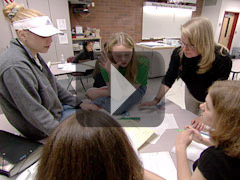
Every spring, millions of school-age children throughout the United States sharpen their No. 2 pencils and prepare to take a battery of standardized tests. It's a ritual that has come to represent the nation's commitment to high academic standards and school accountability.
Parents use test scores to gauge their children's academic strengths and weaknesses, communities rely on these scores to judge the quality of their teachers and administrators, and state and federal lawmakers use these scores to hold public schools accountable for providing the high-quality education every child deserves.
For many, these standardized tests -- and the countless other smaller tests that are commonplace in today's classrooms -- are what come to mind when they hear the term assessment. We look to the end-of-week spelling test, the end-of-quarter biology exam, even the high school exit exam, to tell us whether our children are developing the skills and learning the material they'll need to succeed both in and out of school.
But tests aren't the only way to gauge a student's knowledge and abilities, just as reciting formulas and memorizing the periodic table is not the only way to learn chemistry. Throughout the country, many educators are going beyond traditional tests and using performance assessments in their K-12 classrooms to gauge what students know and can do.
They're designing projects that require students to apply what they're learning to real-world tasks, like designing a school building or improving the water quality in a nearby pond. And they're giving students the experience, as assessment expert Grant Wiggins says, "of being tested the way historians, mathematicians, museum curators, scientists, and journalists are actually tested in the workplace."
In a classroom setting, performance assessment is an essential companion to project learning. By developing comprehensive rubrics by which to evaluate student performances, teachers ensure that projects are more than just fun and engaging activities. They're true tests of a student's abilities and knowledge, linked to standards, and documented so that everyone -- students, parents, and educators -- understands what is being assessed.
The "performance" can include a wide range of activities and assignments: from research papers that demonstrate how well students can evaluate sources and articulate an opinion to experiments or problems that enable a teacher to gauge a student's ability to apply specific math or science knowledge and skills. Some performance assessments consist of individual projects; others require groups of students to work together toward a common goal.
But whatever the project or problem, well-crafted performance assessments share a common purpose: to give students the chance to show what they know and can do and to provide teachers with the tools to assess these abilities.
Assessment in Action
Assessment is a way of life for the 120 students at New York City's Urban Academy: Every day, in every class, students are encouraged and expected to demonstrate what they're learning. In Constitutional Law, they're required to argue a case before a mock Supreme Court. In geometry, they must apply mathematical concepts to measuring the height and volume of buildings or the distance between South Ferry and Staten Island using the Statue of Liberty as a reference point.
And before they receive their high school diploma, students must complete separate performance assessments (known at the Urban Academy as academic proficiencies) that demonstrate their skills and knowledge in six academic areas: mathematics, social studies, science, creative arts, criticism, and literature.
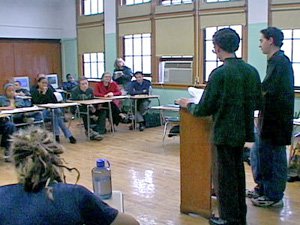
"It's a system of assessment, not a single instrument," says Ann Cook, the Urban Academy's codirector. "It's a system based on a number of components, it goes on all year long, and it culminates in certain kinds of tasks that demonstrate what students can do."
These tasks might include writing a play and having it performed in front of the entire school, reading and studying a piece of literature and then being able to engage in a thoughtful conversation about it, or designing and conducting an original science experiment. With each proficiency, students must be prepared to share their work with classmates, teachers, and outside experts, who routinely lend their real-world expertise to the Urban Academy's assessment process.
The Urban Academy and more than 30 other alternative high schools that are part of the New York Performance Standards Consortium have adopted these rigorous performance assessments as an alternative to the Regents Exams, which high school students throughout New York State are required to pass in English, math, history, and science in order to earn a diploma.
Although their procedures may vary, all consortium schools have adopted a system of assessment aligned to state standards and based on a series of well-defined rubrics, so both the student and the teacher clearly understand the criteria on which work is evaluated. The Performance Assessment Review Board, an external group of educators, test experts, researchers, and members of the business and legal communities, monitors the performance-assessment system and evaluates samples of student work.
The consortium, says Linda Darling-Hammond, Charles E. Ducommon Professor of Education at Stanford University, represents an attempt "to develop high-quality performance assessments that can be evaluated in a reliable way." Darling-Hammond, who has worked with the consortium for more than a decade, points to member schools' high college acceptance rate compared with that of all New York City schools (91 percent versus 62 percent) as a testament to their rigorous curriculum and assessment.
Applied Learning
Across the country, at Mountlake Terrace High School, in Mountlake Terrace, Washington, geometry teacher Eeva Reeder began implementing performance-based assessments when she recognized a disturbing pattern among her students: They could pass a test with flying colors but had considerable difficulty transferring knowledge and skills from one unit to the next.
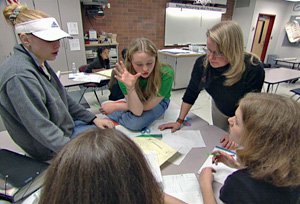
Her response to this dilemma was to incorporate projects into her geometry class -- small-scale projects at the end of each unit of study, as well as a longer-term culminating project -- that require students to apply the abstract skills and formulas to real-world settings.
Completing a project, says Reeder, "is the true test of what you know. You can watch a show where Julia Child makes a soufflé, and you can read about soufflé making," she adds, but the real test is "making one yourself."
In Reeder's class, the true test of her students' geometry skills is an architectural challenge. In six weeks, students must design a high school that will meet the needs of students in 2050. Working in small teams, students are required to develop a site plan, create a scale model, prepare cost estimates, and write a formal proposal. They must also present their plan to their classmates and a group of architects who serve as mentors and judges throughout the project.
Assessment of the design projects occurs in several ways. At the beginning of the project, students are given the scoring rubric by which their work will be measured. Each part of the project is evaluated based on quality and accuracy, clarity and presentation, and concept. Reeder also evaluates teamwork (participation, level of involvement, quality of work as a team member) during the course of the project and at the end.
"There are two reasons for assessment," says Reeder. "One is to provide students feedback on the quality of their work and specifically on how they might improve that quality. The other is to assign a score or grade." Scoring is the easy part, she adds, and can be accomplished with the help of what she calls a "reasonably prepared" test.
"But you can't assess a student's deep understanding of a subject and their ability to apply a concept through a traditional paper-and-pencil, crank-out-the-formulas kind of assessment," says Reeder. "It has to be done with a performance assessment."
Assessing Student Growth
One common form of performance assessment is the development of a student portfolio -- a cumulative record of a student's work over time. It's a practice that's been used at the Key Learning Community, a K-12 school in Indianapolis, since the school first opened its doors in the fall of 1987.
Project learning and student presentation of work is an integral part of the Key Learning assessment program. Every semester, students select and research a project that corresponds to a schoolwide theme. These presentations are documented on videotape, and by the time a student completes eighth grade, he or she has a portfolio documenting as many as 25 projects.
In 1999, Key Learning opened its high school (beginning first with a single class of ninth graders), and with the older students came a move toward improved use of new technologies to capture student work. Now, students begin creating Apple iMovies in middle school and continue using the program throughout high school to document and present their work.
Student progress reports (there are no traditional report cards) are based on Howard Gardner's theory of multiple intelligences and Ernest Boyer's theory of human commonalities.
Before earning their high school diploma, Key Learning seniors must document and demonstrate their applied knowledge in what Boyer identified as eight human commonalities. Among these are the shared use of symbols (through the creation of a major multimedia presentation), shared production and consumption (through a project on marketing and economics), and the shared sense of time and space (through a project on the history of Indianapolis or the contributions of an ethnic group to the development of the city).
As the school's eleventh graders gear up for the college application process, Key Learning is investigating ways to create smaller but representative portfolios of student work on CD-ROMs, which will be made available to college admissions departments.
Time Well Spent
Despite their many differences, these three schools share a common commitment to developing a project-rich curriculum supported and influenced by a thoughtful system of assessment. Teachers, students, and parents all understand that the most effective assessment doesn't happen at the end of a unit. It's woven throughout lessons and projects, often so seamlessly as to be indistinguishable from everyday teaching and learning.
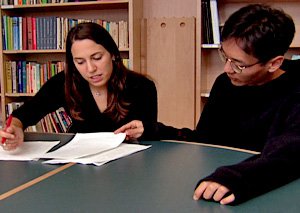
Without question, these high-quality performance assessments take time. The typical research paper at the Urban Academy, for example, will go through multiple revisions before the student and his or her teacher consider it complete. With each revision comes a discussion about key issues to be addressed, questions yet to be answered, and concepts that require further development.
A single proficiency might take a semester or even an entire year for a student to complete and might involve hours and hours of discussions with Urban Academy teachers and an outside evaluator. At Mountlake Terrace, Eeva Reeder spends many hours on just the logistics of her six-week-long architecture project, such as organizing field trips to local architects' office and coordinating classroom activities with the mentors' busy work schedules.
"Performance assessments do engage people in work and time. Students have to develop the performances. The teachers have to evaluate them," acknowledges Stanford's Linda Darling-Hammond. But, she emphasizes, "the time is not lost to teaching and learning. The time is teaching and learning, because the actual conduct of the assessment is a learning experience for students as well as teachers. It informs teaching. It gives teachers immediate feedback about what they need to do to meet a student's needs."
And with that immediate feedback comes the ability to intervene, to change course when assessments show that a particular lesson or strategy isn't working for a student, or to offer new challenges for students who've mastered a concept or skill. In this context, says performance-assessment researcher Karen Sheingold, assessment and learning become "two sides of the same coin" rather than separate and distinct activities.
Assessment Versus Accountability
In many U.S. classrooms and schools, assessment practices aren't just about improving teaching and learning for individual students. They're inextricably bound to the public's demand for greater accountability. All 50 states administer annual assessments to their students, the results of which can determine whether a student is promoted or retained and whether teachers get bonuses or a school gets reconstituted.
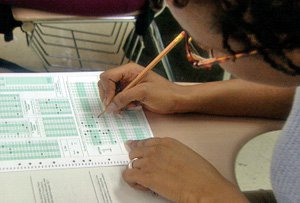
These tests, because of their high stakes, have an incredible influence on classroom practices. For example, nearly 70 percent of the teachers responding to a 2000 Education Week survey on standards and accountability said that state assessments were "forcing them to concentrate too much on what's tested, to the detriment of other important areas of learning." The teachers reported dropping longer units with rich assessment components in favor of more traditional lessons that reflected the type of material and format common in most state assessments.
Few would argue with the need, as Hugh Price, president of the National Urban League, says, to "know whether or not children are learning, and whether they're performing on grade level or better or way below." But when the stakes are too high, this laudable goal gets distorted. Teachers begin teaching to the test to raise scores, often at the expense of more meaningful learning activities. And when the tests are too narrow a measure or aren't properly aligned to standards, they provide little concrete information teachers and schools can use to improve teaching and learning for individual students.
Although most states continue to use multiple-choice and short-answer items on their standardized tests, a handful of states have incorporated additional measures into their annual assessments. The Maryland School Performance Assessment Program for example, is frequently commended for the thoughtful way in which it calls on students to demonstrate multiple abilities in answering a single question or problem. (See Bruce Alberts's Edutopia.org article "Appropriate Assessments for Reinvigorating Science Education.")
In addition, Kentucky and Vermont have incorporated portfolios into their statewide assessments of student achievement -- another effort to offer a broader picture of student achievement, and the now-defunct Massachusetts Reform Review Commission convened representatives from various stakeholder groups to devise a strategy for expanding the Massachusetts Comprehensive Assessment System to make it fairer and more comprehensive.
These additions are important and necessary, says Chris Dede, a professor of education at Harvard University, in order to really understand what students know and can do. "The current reform movement is based on first-generation standards and first-generation assessments for accountability," says Dede. "And while standards and accountability are good," he adds, "the first generation is flawed. Instead of multiple indicators of what students know, we end up with a single test score that somehow is supposed to capture everything that's inside of a student's head."
Dede likens state assessments to an annual visit to the doctor and suggests that we need more, not less, information to gauge a student's knowledge and abilities.
"When I go to a doctor for a physical, it's an indicator of overall wellness," he says. "I don't just want to know about my blood pressure. I want to know about my cholesterol level and a variety of other indicators. Somebody's educational well-being is more complicated than their physical health."In our second generation's standards, we need deeper focus on fewer skills that are central to the 21st century," he adds. "And in our second-generation assessments, we need broader measures, multiple measures that look at the different kinds of things that students have learned and have mastered."